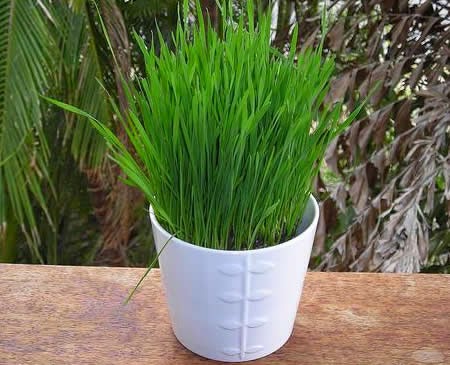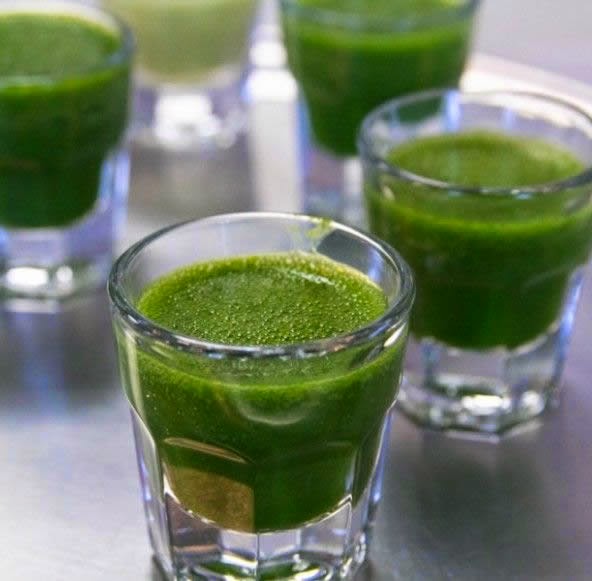 |
| Wheat grass |
Wheat grass, sometimes written as wheatgrass or wheat-grass, is a young green wheat plant (genus Agropyron) harvested before it develops grain kernels and turns the traditional yellow color associated with wheat stalks.
Wheat grass is commonly prepared as a juice, and is consumed either alone, or as a mixture with other juices.
Wheat grass is a source of many nutrients. Differences between samples of wheat grass due to variable growing conditions, quality of seed, and other factors including dose amounts and form will produce variable amounts of nutrients in any single dose of wheat grass.
  |
The following is a partial list.
- biotin
- choline
- lutein
- lycopene
- betacarotene
- thiamine
- riboflavin
- niacin
- pantothenic acid
- pyridoxine
- folic acid
- vitamin C
- vitamin E
- vitamin K
- calcium
- cobalt
- copper
- alanine
- arginine
Although wheat grass contains a wide range of amino acids and other nutrients, the concentrations are low. Relatively large quantities of wheat grass may be required in order to provide significant nutritional benefits.
Origins
There is no well documented history of consumption of wheat grass. Wheat is one of the oldest crops known, and was cultivated as long as 9,000 years ago in the Euphrates Valley of the Middle East.
At least one company has claimed that ingestion of wheat grass dates from the Essenes, a Jewish sect of about the first century A.D. Contemporary use seems to have originated with Ann Wigmore (1909–1994). Ms. Wigmore may be credited with many of the theories concerning enzymes, grasses, and living foods.
Benefits
Wheat grass, depending on the dose, is a dietary supplement, although the concentrations of some nutrients may be low. The sellers of wheat grass have made a large number of claims for the product.
The following list is representative, but not complete.
- cure cancer
- cure chronic fatigue syndrome
- detoxify liver
- purify blood
- neutralize pollutants
- improve energy
- improve circulation
- slow aging
- increase immunity
- protect against biological warfare
Description
Wheat grass is usually grown indoors, either commercially or for personal use. The grass is harvested while still green, and before the wheat kernels have developed. The juice is extracted either with stone grinding, as with a mortar and pestle, or with a manual juicer. High-speed juicers are considered unsuitable, either because they will oxidize the chlorophyll or destroy the enzymes.
Wheat grass juice, according to Ann Wigmore, should be consumed within 30 minutes of juicing.
Wheat grass has a taste that has been described as pungent, however one manufacturer disputes these claims, and maintains that the product has a watermelon or green tea taste.
Preparations
Wheat grass may be purchased in a variety of ways. Kits are available, containing seed, soil, and pots, so that users may grow their own supplies. Alternately, the cut grass is available in packages of 8 or 16 ounces.
Powders and tablets made from dehydrated wheat grass are marketed.
Precautions
No special precautions are required. Because wheat grass juice does not contain gluten, the principle allergen in wheat, the juice may be expected to be safe even for people with wheat allergies.
Side effects
There are no established side effects of wheat grass.
Research and general acceptance
 |
| wheat grass juice |
Wheat grass has not been accepted into conventional medicine at any level. The United States Food and Drug Administration (FDA) and the German Commission E have not reviewed the validity of wheat grass therapy claims.
While some of the claims made for wheat grass are based on laboratory studies, there do not appear to be clinical studies or any form of confirmation from human studies of any form.
While wheat grass contains a large assortment of nutrients, the concentrations are low, and a large volume of juice or powder would be required in order to make a significant contribution to health. Arguments regarding the of benefits orally ingested enzymes have been generally rejected, because enzymes are destroyed during digestion.
Iklan
 |
| Wheat grass |
Wheat grass, sometimes written as wheatgrass or wheat-grass, is a young green wheat plant (genus Agropyron) harvested before it develops grain kernels and turns the traditional yellow color associated with wheat stalks.
Wheat grass is commonly prepared as a juice, and is consumed either alone, or as a mixture with other juices.
Wheat grass is a source of many nutrients. Differences between samples of wheat grass due to variable growing conditions, quality of seed, and other factors including dose amounts and form will produce variable amounts of nutrients in any single dose of wheat grass.
  |
The following is a partial list.
- biotin
- choline
- lutein
- lycopene
- betacarotene
- thiamine
- riboflavin
- niacin
- pantothenic acid
- pyridoxine
- folic acid
- vitamin C
- vitamin E
- vitamin K
- calcium
- cobalt
- copper
- alanine
- arginine
Although wheat grass contains a wide range of amino acids and other nutrients, the concentrations are low. Relatively large quantities of wheat grass may be required in order to provide significant nutritional benefits.
Origins
There is no well documented history of consumption of wheat grass. Wheat is one of the oldest crops known, and was cultivated as long as 9,000 years ago in the Euphrates Valley of the Middle East.
At least one company has claimed that ingestion of wheat grass dates from the Essenes, a Jewish sect of about the first century A.D. Contemporary use seems to have originated with Ann Wigmore (1909–1994). Ms. Wigmore may be credited with many of the theories concerning enzymes, grasses, and living foods.
Benefits
Wheat grass, depending on the dose, is a dietary supplement, although the concentrations of some nutrients may be low. The sellers of wheat grass have made a large number of claims for the product.
The following list is representative, but not complete.
- cure cancer
- cure chronic fatigue syndrome
- detoxify liver
- purify blood
- neutralize pollutants
- improve energy
- improve circulation
- slow aging
- increase immunity
- protect against biological warfare
Description
Wheat grass is usually grown indoors, either commercially or for personal use. The grass is harvested while still green, and before the wheat kernels have developed. The juice is extracted either with stone grinding, as with a mortar and pestle, or with a manual juicer. High-speed juicers are considered unsuitable, either because they will oxidize the chlorophyll or destroy the enzymes.
Wheat grass juice, according to Ann Wigmore, should be consumed within 30 minutes of juicing.
Wheat grass has a taste that has been described as pungent, however one manufacturer disputes these claims, and maintains that the product has a watermelon or green tea taste.
Preparations
Wheat grass may be purchased in a variety of ways. Kits are available, containing seed, soil, and pots, so that users may grow their own supplies. Alternately, the cut grass is available in packages of 8 or 16 ounces.
Powders and tablets made from dehydrated wheat grass are marketed.
Precautions
No special precautions are required. Because wheat grass juice does not contain gluten, the principle allergen in wheat, the juice may be expected to be safe even for people with wheat allergies.
Side effects
There are no established side effects of wheat grass.
Research and general acceptance
 |
| wheat grass juice |
Wheat grass has not been accepted into conventional medicine at any level. The United States Food and Drug Administration (FDA) and the German Commission E have not reviewed the validity of wheat grass therapy claims.
While some of the claims made for wheat grass are based on laboratory studies, there do not appear to be clinical studies or any form of confirmation from human studies of any form.
While wheat grass contains a large assortment of nutrients, the concentrations are low, and a large volume of juice or powder would be required in order to make a significant contribution to health. Arguments regarding the of benefits orally ingested enzymes have been generally rejected, because enzymes are destroyed during digestion.

Post a Comment